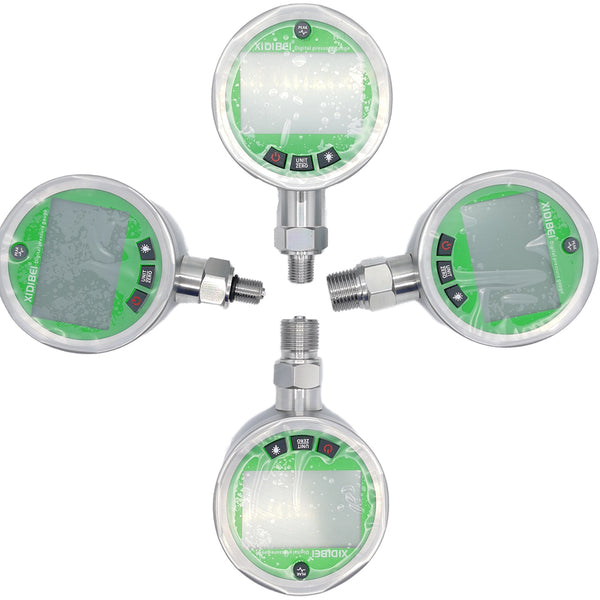In today's world, precise measurement tools are essential. Among them, digital pressure gauges stand out for their accuracy and clarity. These modern devices have revolutionized how we measure pressure, replacing traditional analog counterparts. But how do they manage to give us those clear, digital readings? Let's delve into the fascinating workings of digital pressure gauges and uncover the magic behind those digital numbers that make our tasks simpler and more efficient.
What are digital pressure gauges?
Digital pressure gauges are modern tools that measure and display pressure values electronically. Unlike traditional analog gauges, they show readings on digital screens, often with higher accuracy. They can store and sometimes even transmit data. Their digital nature allows for clearer reading, reducing errors. They work in various settings, from industries to home use. Many come with additional features, such as backlight displays or multiple measurement units. Digital gauges require batteries or external power sources.
How do digital pressure gauges work?
Digital pressure gauges have become quite popular in many industries because they provide accurate and clear readings. If you've ever wondered how they function, let's see their working mechanism in simple terms.
Core Component: Pressure Transducer
Every digital pressure gauge starts with a pressure transducer. This vital component senses the pressure and produces an electrical response.
Conversion of Pressure into Signal
When force or pressure applies to the transducer, it creates an electrical signal. The strength of this signal relates directly to the pressure level.
Digital Processing Unit
The gauge contains a digital processing unit or microprocessor. This unit takes the electrical signal from the transducer and processes it.
Display of Readings
Once processed, the digital signal turns into a readable value, showing up on the gauge's digital display. This value typically presents in units like PSI, bar, or Pa.
Digital Display Advantages
A key benefit of digital displays is clarity. There's no needle ambiguity as with analog gauges. You get precise, clear numbers every time.
Power Sources Vary
Digital pressure gauges often run on batteries. Some models, especially industrial ones, might connect to external power sources.
Calibration is Crucial
For accurate readings, gauges need periodic calibration. Many digital models have built-in calibration reminders or features, ensuring consistent accuracy.
Multiple Measurement Units
One significant advantage is the ability to switch between measurement units. Users can often toggle between PSI, bar, kPa, and more, depending on the gauge's features.

Added Features: Backlight and Alerts
Many modern gauges come with backlit displays, making reading in low light conditions easier. Some even have alert features, signaling when pressure is too high or low.
Data Storage and Transmission
Advanced models can store pressure readings over time. This feature is beneficial for tracking and analysis. Some gauges even allow for data transmission, sending readings to computers or other devices.
Environment and Durability
Digital pressure gauges often have protective casings. These make them durable against harsh environments, like extreme temperatures or moisture.
Sensor Types Differ
Different gauges use different types of sensors, like piezoresistive, capacitive, or piezoelectric sensors. Each has its advantages and preferred applications.
Auto-Off Feature
To save battery life, many digital gauges come with an auto-off feature. After a period of inactivity, the gauge will shut itself off.
Temperature Compensation
Some advanced gauges have temperature compensation. This feature adjusts readings, considering temperature changes, ensuring accurate pressure measurements in varying conditions.
User-Friendly Interfaces
Many digital pressure gauges prioritize user-friendliness. They have intuitive buttons and menus, allowing users to navigate features and settings easily.
Compatibility with Systems
These gauges often come with threaded ends or connectors. This design ensures they fit well in various systems, from industrial setups to home applications.
Maintenance and Care
While digital pressure gauges boast durability, proper care ensures longevity. Regular cleaning and protection from extreme conditions can extend their lifespan.
Accuracy and Resolution
One reason these gauges are popular is their high accuracy and resolution. They can detect minute changes in pressure, providing detailed and precise readings.
Cost and Affordability
While digital pressure gauges might cost more initially than their analog counterparts, their features and accuracy often justify the investment.
Safety Precautions
Always use gauges within their specified pressure and temperature ranges. Overloading can damage the gauge and compromise safety.
Applications are Diverse
From car tires and HVAC systems to industrial machinery and research labs, digital pressure gauges serve a wide range of applications. Their versatility is truly impressive.
Digital pressure gauges are marvels of modern engineering, blending accuracy, user-friendliness, and versatility. If you're in a field that requires precise pressure measurements, considering a digital gauge might be a wise choice.
FAQs
What is the main advantage of using a digital pressure gauge over an analog one?
Digital pressure gauges offer clearer readings, eliminating needle ambiguity. They often provide higher accuracy and feature-rich functionalities.
How often should I calibrate my digital pressure gauge?
Calibration frequency varies by usage and model. For consistent accuracy, it's advisable to follow the manufacturer's guidelines or calibrate annually.
Do digital pressure gauges work with both liquids and gases?
Yes, many digital pressure gauges can measure pressure in both liquids and gases. Always check the product specifications to be sure.
How do digital pressure gauges get powered?
Most digital gauges run on batteries. Some, especially industrial ones, might connect to external power sources.
Can I store and transfer data with a digital pressure gauge?
Many advanced models allow data storage and transmission. You can track readings over time and sometimes even send data to other devices.



Leave a comment